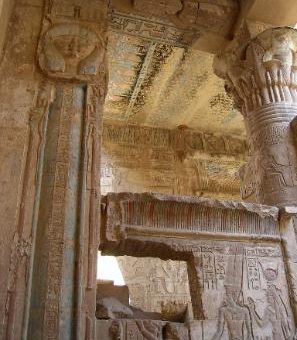
The most prominent temple at Deir el-Medina is the Ptolemaic temple. It was dedicated
to goddesses Hathor and Maat. The building itself is small but belongs to one of the best
preserved examples of a temple from that period that is still standing today. It sits
within a tall mud-brick enclosure wall. Its compound embraces the sites of several New
Kingdom temple structures and small chapels erected by Deir el-Medina inhabitants at
the Northern side of their settlement
The temple itself was built and decorated in the 3rd
century BC. The work was started during the reign of
Ptolemy IV Philopator (222-205 BC) and then was
continued for the next 60 years under Ptolemy VI
Philometor (180-164, 163-145 BC) and Ptolemy VIII
Euergetes II (170-164, 145-116 BC)
View towards mammisi (the birth house) of
Ptolemy IX Soter II (116-80 BC) and
Cleopatra III. Both are visible here in the
wall relief, facing Amun, Mut and Khonsu
(who are not visible in the photo).
The temple itself is entered via a
vestibule that has two papyrus
columns. The pronaos, that lies beyond
the vestibule, is defined by a pair of
columns, pillars, and curtain walls.
The view on the left looks from the
vestibule, through pronaos into the
central chapel.
Hathoric and floral columns and extensive decoration
are characteristic for this temple. This is the view
looking through the columns above the curtain wall.
The curtain wall is covered with reliefs showing
the king offering to various deities. Below is the
eastern face of the curtain wall – Ptolemy VI
Philometor facing Amun-Ra and Hathor.
…to the interior of the temple as recorded
by the Commission des arts et des sciences in
Description de l’Egypte by the artists, who
arrived in Egypt with Napoleon’s army in July
of 1798. They called the site “du temple de
l’ouest” in their publication
